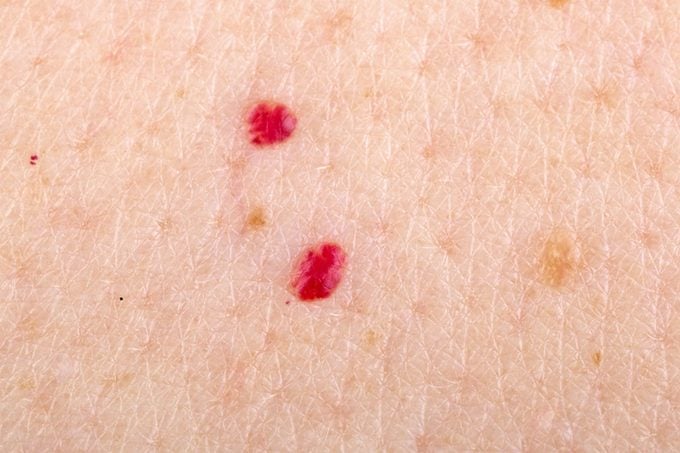This Is How to Get Rid of Those Bright Red ‘Moles,’ According to Dermatologists
Updated: Jan. 18, 2020
Don't just ignore the harmless-looking red spots. Here's everything you need to know about cherry angiomas.

In your 30s, you might start noticing little red circular bumps popping up on your body. They look like bright red moles, but they’re actually growths of blood vessels called cherry angiomas. No one is sure what causes them, but it seems to be genetic. So if your mom and dad had them, there’s a good chance you’ll get some, too.
Could it be something more concerning?
Cherry angiomas aren’t dangerous, so there’s no medical reason to remove them. Still, you should schedule a visit with your dermatologist when you notice one, says Anthony Rossi, MD, Mohs surgeon at Memorial Sloan Kettering Cancer Center in New York City. What you think is a harmless growth could actually be more sinister. “Usually we think of melanoma as being a dark, black mole, but there are other types of skin cancer like melanoma or Merkel cell carcinoma that can present as little red papules,” he says. Find out why two types of skin cancer are skyrocketing.
Whether you want to take the cherry angioma off or not, your derm can check it—and the rest of your body—for signs of cancer. That’s why it’s also important to visit a dermatologist instead of an aesthetician who isn’t medically trained, adds Ivy Lee, MD, a dermatologist based in Pasadena, California. Those medical spas can remove the spots, but won’t test to confirm they aren’t serious. In-between visits, you need to know how to check for skin cancer.
Can I remove them myself?
Once you know your spot is a harmless cherry angioma, you might be tempted to snip it off at home. Bad idea.
A DIY method could leave a scar, and because cherry angiomas are made of blood vessels, a basic Band-Aid might not stop the bleeding. “They could go to urgent care to stop the bleeding,” says Dr. Lee. “That’s much more expensive than ever getting it treated.” It’s also why you should always visit a dermatologist before removing a skin tag.
Zap them off
For small cherry angiomas, your dermatologist could use a device called a hyfrecator. “It’s basically a very fine-tip needle and delivers a little bit of heat and electricity to seal up those blood vessels,” says Dr. Lee. Your derm will apply a numbing cream first, but the treatment might still hurt a bit, she says.
When laser treatment makes sense
Larger spots might require a laser that can target the specific blood vessels. “It’s pretty cool—you can see them get dark and then involute and get smaller,” says Dr. Rossi. That option is also less painful than the needle, says Dr. Lee. Each pass of the laser feels sort of like the snap of a rubber band. Speaking of lasers, get the facts before you set up a laser hair removal appointment.
Laser treatments can get expensive, so you could also ask your dermatologist to shave the cherry angioma off with a scalpel—no fancy equipment required, says Dr. Rossi.
Freezing them off may be an option
If all this cutting and zapping isn’t your speed, consider freezing the spot off with cryotherapy. Just beware: Freezing equipment isn’t as precise, so it’s more likely to leave a dark or light mark. Dr. Lee only recommends it for very light-skinned patients, whose skin would be less likely to show a white mark. Don’t miss the secret ingredient that keeps scratches from scarring.
And no shame if all this doesn’t sound worth the hassle. “I want to reassure folks these are benign, and only if they bother them do they have to treat them,” says Dr. Lee.
